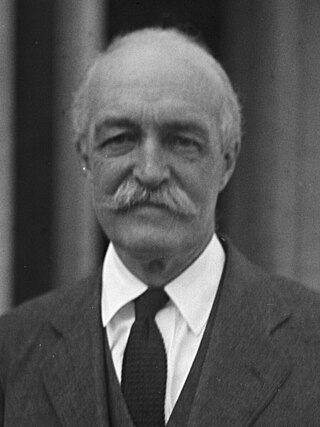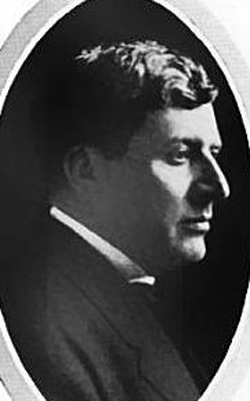Related Research Articles

Gifford Pinchot was an American forester and politician. He served as the fourth chief of the U.S. Division of Forestry, as the first head of the United States Forest Service, and as the 28th governor of Pennsylvania. He was a member of the Republican Party for most of his life, though he joined the Progressive Party for a brief period.

The Heinz College of Information Systems and Public Policy, also known as Heinz College, is the public policy and information college of Carnegie Mellon University in Pittsburgh, Pennsylvania. It consists of the School of Information Systems and Management and the School of Public Policy and Management. The college is named after CMU's former instructor and the later U.S. Senator John Heinz from Pennsylvania.
Charles Zeller Klauder was an American architect best known for his work on university buildings and campus designs, especially his Cathedral of Learning at the University of Pittsburgh, the first educational skyscraper.

Amos Richards Eno Pinchot was an American lawyer and reformist. He never held public office but managed to exert considerable influence in reformist circles and did much to keep progressive and Georgist ideas alive in the 1920s.

Carl Henry Eigenmann was a German-American ichthyologist of the late nineteenth and early twentieth centuries, who, along with his wife Rosa Smith Eigenmann, and his zoology students is credited with identifying and describing for the first time 195 genera containing nearly 600 species of fishes of North America and South America. Especially notable among his published papers are his studies of the freshwater fishes of South America, the evolution and systematics of South American fishes, and for his analysis of degenerative evolution based on his studies of blind cave fishes found in parts of North America and in Cuba. His most notable works are The American Characidae (1917–1929) and A revision of the South American Nematognathi or cat-fishes (1890), in addition to numerous published papers such as "Cave Vertebrates of North America, a study of degenerative evolution" (1909) and "The fresh-water fishes of Patagonia and an examination of the Archiplata-Archelenis theory" (1909).
Andrey Avinoff ; was an internationally-known artist, lepidopterist, museum director, professor, bibliophile and iconographer, who served as the director of the Carnegie Museum of Natural History in Pittsburgh from 1926 to 1945.
Carl Alwin Schenck was a German forester and pioneering forestry educator. When Schenck came to the United States to work for George W. Vanderbilt at the Biltmore Estate, he became the third formally trained forester in the United States. He established and operated the Biltmore Forest School, the first forestry school in North America, on Vanderbilt's property.

Clarence Erwin McClung was an eminent American zoologist and prairie pioneer cytologist who discovered the role of chromosomes in sex-determination.

Richard Howland Hunt was an American architect and member of the Hunt family of Vermont who worked with his brother Joseph Howland Hunt in New York City at Hunt & Hunt.

The Pennsylvania State Employees’ Retirement System is an independent administrative board of the Commonwealth of Pennsylvania that manages the public pension system for state employees in Pennsylvania.

John Paul Harris was a Pittsburgh businessman and politician who opened the world's first theater devoted entirely to showing Motion pictures.

Ellwood Jackson Turner was an American politician from Pennsylvania who served as a Republican member of the Pennsylvania House of Representatives for Delaware County from 1925 to 1948 and as the 119th Speaker of the Pennsylvania House of Representatives from 1939 to 1941.

The 1930 Pennsylvania gubernatorial election occurred on November 4, 1930. Incumbent Republican governor John Stuchell Fisher was not a candidate for re-election. Republican candidate and former governor Gifford Pinchot defeated Democratic candidate John M. Hemphill to win a second, non-consecutive term as Governor of Pennsylvania.

The 1934 Pennsylvania gubernatorial election occurred on November 6, 1934. Incumbent Republican governor Gifford Pinchot was not a candidate for re-election.

George Elias Alter was an American lawyer and politician, who served one term as attorney general of the Commonwealth of Pennsylvania.
Ruth Pickering Pinchot was an American writer, critic, and activist.
Frank Dunn Kern was an American plant pathologist and university administrator. He was a faculty member at Pennsylvania State University, holding appointments as Head of the Department of Botany and Dean of the Graduate School. He was an expert on the Pucciniales.

Cornelia Elizabeth Bryce Pinchot, also known as “Leila Pinchot,” was a 20th-century American conservationist, Progressive politician, and women’s rights activist who played a key role in the improvement of Grey Towers, the Pinchot family estate in Milford, Pennsylvania, which was donated to the U.S. Forest Service in 1963 and then designated as a National Historic Landmark in 1966. A maternal great-granddaughter of Peter Cooper, founder of Cooper Union, and daughter of U.S. Congressman and Envoy Lloyd Stephens Bryce (1851–1917), she was the wife of Gifford Pinchot (1865-1946), the renowned conservationist and two-time Governor of the Commonwealth of Pennsylvania, and was also a close friend of U.S. President Theodore Roosevelt.
Anolis pinchoti, also known commonly as the Crab Cay anole, is a species of lizard in the family Dactyloidae. The species is endemic to Colombia.

Frederick Erskine Olmsted, also known as Fritz Olmsted, was an American forester and one of the founders of American forestry. Through his work with the United States Forest Service, Olmsted helped establish the national forest system in the United States and helped train the next generation of Forest Service agents and college professors. He was instrumental in the creation of at least twenty national forests in California and Alaska including the Muir Woods National Monument and Tongass National Forest. He also wrote the Use of National Forest Resources, a foundational Forest Service manual that laid the groundwork for the nation's enduring forest management system, elements of which remain in use today.
References
- ↑ "Pennsylvania Academy of Science". pennsci.org. Pennsylvania Academy of Science. Retrieved 17 October 2021.
- ↑ GuideStar.org New York Academy of Sciences Archived 2015-11-14 at the Wayback Machine , accessed October 28, 2015
- 1 2 "Officers – Pennsylvania Academy of Science". pennsci.org. Pennsylvania Academy of Science. Retrieved 17 October 2021.
- 1 2 "Otto Jennings Archives". Carnegie Museum of Natural History. Carnegie Museum. Retrieved 25 November 2021.
- ↑ "Grey Towers National Historic Site". Grey Towers National Historic Site. US Forest Service. Retrieved 18 October 2021.
- ↑ Pinkett, Harold T. (1957). "GIFFORD PINCHOT AT BILTMORE". The North Carolina Historical Review. JStor. pp. 346–357. Retrieved 18 October 2021.
- ↑ "The Proceedings of the Pennsylvania Academy of Science". Proceedings of the Pennsylvania Academy of Science. 1 (1): 1. 1926.
- ↑ "The Proceedings of the Pennsylvania Academy of Science". Proceedings of the Pennsylvania Academy of Science. 61 (2). April 1987.
- ↑ "Journal of the Pennsylvania Academy of Science". Journal of the Pennsylvania Academy of Science. 62 (1). September 1988.
- ↑ Energy, Environment, and Economy. Easton, Pennsylvania: The Pennsylvania Academy of Science. 1981. p. 228. ISBN 0-9606670-0-8.
- ↑ "DR. OTTO E. JENNINGS". The New York Times. The New York Times. 1 February 1964. Retrieved 28 November 2021.
- ↑ "Otto Jennings Archives". Carnegie Museum of Natural History. Retrieved 28 November 2021.
- ↑ "History of the Organization". Proceedings of the Pennsylvania Academy of Science. 1 (1): 9. 1926.
- ↑ "History of Organization-First Meeting". Proceedings of the Pennsylvania Academy of Science. 1 (1): 10. 1926.
- ↑ "Panah recognized by American Junior Academy of Science (News) | University of Pittsburgh at Bradford". www.upb.pitt.edu. University of Pittsburgh. Retrieved 18 October 2021.
- ↑ "Dr. George C. Shoffstall Obituary". Journal of the Pennsylvania Academy of Science. 69 (Supplement and Index): 122A. March 1996.
- ↑ "Dr. George C. Shoffstall President". Proceedings of the Pennsylvania Academy of Science. 58 (1): 3. 1984.